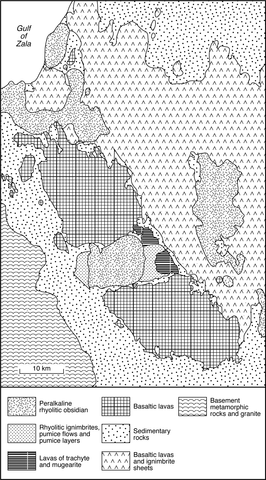stripes
The Alid volcano lies at the northern end of the Danakil Depression. Three units are distinguished by Barberi et al. (1973): a central silicic complex and northern and southern basaltic lava fields. The silicic complex forms a strato-volcano surmounted by a caldera and consists mainly of pyroclastic rocks, including ignimbrites, with few lava flows. The most recent activity, including production of rhyolite domes, obsidian flows and pumice deposits, occurred principally on the eastern flanks. The silicic rocks are reported by Barberi et al. (1973) to be peralkaline but analyses of pyroxene in a granophyric block given by Lowenstern et al. (1997) indicate only about 0.5 wt% Na2O. However, the latter authors do not give data for the rhyolites.
BARBERI, F., CHEDEVILLE, E., FAURE, H., GIGLIA, G., MARINELLI, G., SANTACROCE, R., TAZIEFF, H. and VARET, J. 1973. Geology of Northern Afar (Ethiopia) (with a geological map, scale 1:500,000). Revue de Geographie Physique et de Geologie Dynamique, Paris, 15: 443-89.LOWENSTERN, J.B., CLYNNE, M.A. & BULLEN, T.D. 1997. Comagmatic A-type granophyre and rhyolite from the Alid volcanic center, Eritrea, northeast Africa. Journal of Petrology, 38, 1707-1721.

